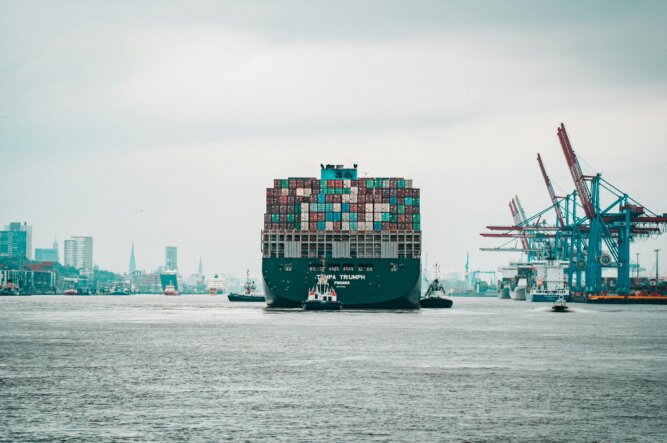Supply Chain Transportation and the Impact of Disruptive Events

Listen up!
Check out our podcast, Freight Nation, where industry experts talk all things trucking.
Drought, geopolitical conflict, and a bridge collapse were three factors that put pressure on the supply chain in early 2024. When a disruption occurs in the supply chain, the impact can be immediate and predictable, or sometimes the impact isn’t apparent until years later.
We’ll look at the supply chain’s ability to adapt to disruptions. We’ll also explore factors that influence the predictability of supply chain impacts and include insights from the busiest port in North America.
COVID and the Supply Chain Challenges
Before we get into 2024 supply chain disruptions, it’s worth looking back at 2021 to understand how a supply chain crisis can develop.
A surge in pandemic-fueled e-commerce demand overwhelmed ports. Warehouses struggled to transport and accommodate cargo volume, yet companies continued to order stock to keep up with consumer demand. Christopher Chase, Assistant Director of Marketing for the Port of Los Angeles, saw this crisis unfold in real time, as shipping containers piled up at the port.
“It’s all about velocity,” Chase explained in a recent episode of Truckstop’s podcast Freight Nation. “And velocity is what keeps us flowing. We have finite real estate. As a port, we have X amount. And if it gets too full, you can’t take things out then.”
With no space to unload, container ships lingered off the California coast.
“You can hold a ship offshore, it’s a floating warehouse, and you’ve got to wait for things to clear up on the land side,” Chase said.
Ultimately, untangling the COVID supply chain challenges required swift adaptation, with the port and major importers moving to 24/7 operation, and union workers committing to additional shifts.
Adaptation and temporary workarounds can help alleviate supply chain disruptions — some of them, at least.
The Suez Canal: Then and Now
Another recent and noteworthy supply chain problem involved the Ever Given, a 1,300-foot ship with a 20,000-container capacity, ran aground in the Suez Canal in 2021, blocking all shipping lanes. The blockage marooned more than 150 ships carrying billions of dollars in cargo. That incident, however, was temporary — “a very fixable direct problem,” in Chase’s words.
However, current Suez Canal shipping interruptions are proving to be much more complicated. Suez Canal shipping traffic for the first two months of 2024 was 50% lower than 2023 January-February traffic. This decline was a result of Yemen rebels — Houthis — attacking international ships in the Red Sea, which ships must cross to reach the canal. These attacks intensified as conflicts gained momentum, with Houthis targeting more than 40 vessels since November 2023.
Route Realignment Consequences
In response to this ongoing violence, many major shipping carriers, including Maersk, decided to reroute vessels around the Cape of Good Hope in South Africa. Depending on a ship’s final destination, that route can increase travel time by a week or more — and it requires a lot more fuel.
“And that, all of a sudden, starts adding up to some big bucks,” Chase said. “And that’s probably the longer-term impact is the fuel cost and the longer supply chains and how that affects the person who’s shipping it, the timeline on delivery, and of course, the cost in fuel and the time and everything else you’re working with.”
To offset their costs and travel time, the shipping giants Maersk and CMA CGM announced surcharges ranging between $325 to $700 per 20-foot container, depending on the travel route.
Overseas conflicts, ongoing Houthi attacks, and the ensuing U.S. and British air strikes against Yemen have created a turbulent and unpredictable situation in the Red Sea. Unlike the 2021 Suez Canal blockage, there’s no obvious solution, nor is there any clarity about how long all of this will last. So the true impact on the supply chain is difficult to predict.
Another Canal Threatens Supply Chain Stability
Across the Atlantic Ocean, another key shipping canal has experienced a significant disruption. Due to an unprecedented drought, the lake that feeds the Panama Canal was at record-low levels heading into 2024. With water levels too low to accommodate large ships, the canal’s traffic was down by 20% in the first quarter, with canal administrators projecting a loss of $500 million to $700 million in FY 2024.

A look at how shipping routes have changed since January 2023.
Recent rains have allowed the canal to accommodate more traffic. But this is another disruption with an unpredictable impact on the supply chain.
The Francis Scott Key Bridge Collapse
On March 26, a cargo ship struck Francis Scott Key Bridge, causing it to collapse, killing six construction workers and disabling the Port of Baltimore. While this Baltimore port isn’t the busiest in North America — according to the American Journal of Transportation, it’s ranked number 15 on the list of top 20 North American Ports based on tonnage and total container capacity. The port also has a few unique qualities that make it a critical part of international trade.
The Port of Baltimore is the furthest inland of any U.S. port, and closest to the Midwest, which is where the majority of automobile manufacturing occurs. The port can also accommodate larger ships than other East Coast ports, thanks to its recent expansion of 50-foot-deep berth space.
The bridge collapse didn’t significantly disrupt the U.S. automotive trade, as automakers had deep contingency plans and enough stock to weather supply chain disruptions. And for now, they’re rerouting parts and vehicles to other ports. But it created a long-term cleanup effort with an unknown projected timeline. In an effort to expedite the process, the U.S. Coast Guard opened a temporary alternate channel to support salvage and cleanup efforts.
Ships are now offloading more containers at the Ports of New York and New Jersey, as well as the Port of Virginia, for all types of cargo. This means carriers may be in high demand to transport cargo originally earmarked for Baltimore to its final destination.
The Challenges of Evaluating Impact
For singular events like the Key bridge collapse, diverting to other ports or reconfiguring modes of transportation to move goods can minimize supply chain disruption while a solution is in progress. But the impact on the supply chain can be significant and ongoing for issues with an unpredictable resolution — like geopolitical conflict or extreme weather.
In our next post, we’ll drill down into how supply chain health impacts trucking and include insights from Lee Klaskow, Senior Analyst of Freight Transportation and Logistics at Bloomberg Intelligence and host of Talking Transports.
Navigate with Rate Precision
Staying informed about rate fluctuations is crucial for truck drivers navigating the complex landscape of supply chain disruptions. Understanding these changes empowers you to make strategic decisions that optimize your business operations.
By leveraging tools like Truckstop’s Rate Insights, drivers gain access to real-time data, enabling them to adapt to market dynamics swiftly. Whether it’s identifying lucrative opportunities or adjusting routes to avoid areas with reduced demand, Rate Insights is a valuable tool to help maximize profitability and efficiency. Learn how data-driven decisions can accelerate your business today.
Get helpful content delivered to your inbox.
Sign up today.
Find high-quality loads fast, get higher rates on every haul, and access tools that make your job easier at every turn.






